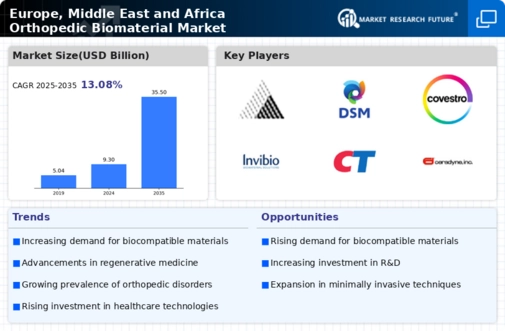Market Share
Europe Orthopedic Biomaterial Market Share Analysis
The EMEA (Europe, the Middle East, and Africa) Orthopedic Biomaterial Market is a critical sector within the healthcare industry, focusing on the development and application of biomaterials in orthopedic procedures. Companies operating in this region employ various strategic approaches to enhance market share positioning and address the diverse needs of the orthopedic community. The core strategy in the EMEA Orthopedic Biomaterial Market is regulatory compliance. Organizations give preference to compliance with tough regulatory standards imposed by institutions such as the European Medicines Agency (EMA) and local health authorities in Middle East & Africa. Compliance not only provides legal acceptance but also creates credibility and confidence among stakeholders. Taking note of the regional differences in healthcare needs across Europe, Middle East and Africa countries companies emphasize on product customization. Customizing orthopedic biomaterials to suit the needs of each market segment guarantees relevance and efficiency in targeting the individual patient demographics per region’s unique requirements and preferences. Companies interested in stabilizing their market position on the EMEA region are likely to expand geographically. By setting up their regional offices, distribution centers and manufacturing plants in Europe, the Middle East and Africa at strategic locations a business would be able to act fast on local needs thus enhancing its market strength. Establishing strategic partnerships with health care providers, such as hospitals and orthopedic clinics are the typical direction. These collaborations support product adoption, physician involvement and offer significant information for product innovation. Partnership with local healthcare organizations increases the market penetration as well as acceptance of orthopedic biomaterials. Continuous innovation through R&D initiatives is a necessity for any firm to remain competitive. The firms invest in the development of biomaterial technologies, new formulations and product attributes. Being at the very mention of scientific achievements allows companies to provide innovative orthopedic solutions, which attracts both clinicians and patients. Strategically, educating the patients and healthcare professionals on the advantages of orthopedic biomaterials is an effective marketing strategy. Businesses create patient education programs that emphasize the benefits of biomaterials in orthopedic procedures, increasing awareness and forming a favorable opinion among end-users. Marketing strategies are designed to be considerate of the various cultures and languages that pervade in EMEA. Companies create marketing initiatives that appeal to localities and build up the benefits of orthopedic biomaterials on a patient’s well-being while dealing with region peculiar health issues. The training of the health care professionals in proper utilization and application procedures of orthopedic biomaterials is a concern. Companies invest in training programs and skill development initiatives for surgeons, medical staff as such measures are aimed at proper utilization of product which leads to positive patient outcomes. In a diverse economic landscape, adopting competitive pricing strategies is essential. Companies carefully analyze market dynamics, considering regional economic variations, healthcare reimbursement structures, and consumer purchasing power. Implementing competitive pricing ensures accessibility and affordability of orthopedic biomaterials, contributing to market share growth.

















Leave a Comment